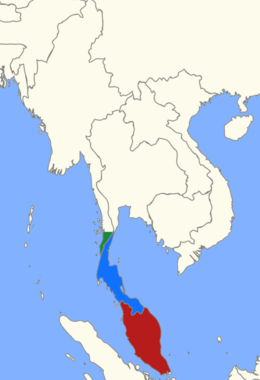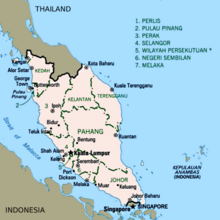Malay Peninsula
 Location of the Malay Peninsula | |
| Geography | |
|---|---|
| Location | Southeast Asia |
| Coordinates | 7°00′N100°00′E/ 7.000°N 100.000°E |
| Adjacent to | Indian Ocean,Pacific Ocean |
| Area | 242,363.8 km2(93,577.2 sq mi) |
| Highest elevation | 2,187 m (7175 ft) |
| Highest point | Mount Tahan |
| Administration | |
| Peninsular Malaysia | |
| Largest settlement | Kuala Lumpur |
| Region | Tanintharyi |
| District | Kawthaung |
| Largest settlement | Kawthaung |
| Southern Thailand | |
| Largest settlement | Hat Yai |
TheMalay Peninsula[a]is located inMainland Southeast Asia.Thelandmassruns approximately north–south, and at its terminus, it is the southernmost point of the Asian continental mainland. The area containsPeninsular Malaysia,Southern Thailand,and the southernmost tip ofMyanmar(Kawthaung). Theisland countryofSingaporealso has historical and cultural ties with the region.
TheTitiwangsa Mountainsare part of theTenasserim Hillssystem and form the backbone of the peninsula and the southernmost section of the centralcordillera,which runs fromTibetthrough theKra Isthmus,the peninsula's narrowest point, into the Malay Peninsula.[1]TheStrait of Malaccaseparates the Malay Peninsula from the Indonesian island ofSumatra,and the south coast is separated from the island ofSingaporeby theStraits of Johor.
Etymology[edit]
The Malay termTanah Melayuis derived from the wordTanah(land) andMelayu(Malays), thus it means "the Malay land". The term can be found in various Malay texts, of which the oldest dating back to the early 17th century. It is frequently mentioned in theHikayat Hang Tuah,a well-known classic tale associated with the legendary heroes ofMalacca Sultanate.Tanah Melayuin the text is consistently employed to refer to the area under Malaccan dominance.[2]
In the early 16th century,Tomé Pires,a Portugueseapothecarywho stayed inMalaccafrom 1512 to 1515, uses an almost identical term,Terra de Tana Malaio,with which he referred to the southeastern part of Sumatra, where the deposed sultan of Malacca,Mahmud Shah,established his exiled government. The 17th century's account of Portuguese historian,Emanuel Godinho de Erédia,noted on the region ofMalaiossurrounded by theAndaman Seain the north, the entireStrait of Malaccain the centre, a part ofSunda Straitin the south, and the western part ofSouth China Seain the east.[3]
Prior to the foundation of Malacca, ancient and medieval references to a Malay peninsula exist in various foreign sources. According to several Indian scholars, the wordMalayadvipa( "mountain-insular continent" ), mentioned in the ancient Indian text,Vayu Purana,may possibly refer to the Malay Peninsula.[4][5][6]Another Indian source, an inscription on the south wall of theBrihadeeswarar Temple,recorded the wordMalaiur,referring to a kingdom in the Malay Peninsula that had "a strong mountain for its rampart".[7][8]Ptolemy'sGeographianamed a geographical region of theGolden ChersoneseasMaleu-kolon,a term thought to derive from Sanskritmalayakolamormalaikurram.[9]While the Chinese chronicle of theYuan dynastymentioned the wordMa-li-yu-er,referring to a nation of the Malay Peninsula that was threatened by the southward expansion of theSukhothai Kingdomunder KingRam Khamhaeng.[10][11]During the same era,Marco Polomade a reference toMalauirin histravelogue,as a kingdom located in the Malay Peninsula, possibly similar to the one mentioned in the Yuan chronicle.[12][13]The Malay Peninsula was conflated withPersiain old Japan, and was known by the same name.[14]
In the early 20th century, the termTanah Melayuwas generally used by the Malays of the peninsula during the rise ofMalay nationalismto describe uniting allMalay stateson the peninsula under one Malay nation, and this ambition was largely realised with the formation ofPersekutuan Tanah Melayu(Malayfor "Federation of Malaya") in 1948.[15]
Ecology[edit]
The Malay Peninsula is covered withtropical moist broadleaf forests.Lowland forests are dominated bydipterocarptrees, while montane forests are home to evergreen trees in the beech family (Fagaceae), Myrtle family (Myrtaceae), laurel family (Lauraceae), tropicalconifers,and other plant families.
The peninsula's forests are home to thousands of species of animals and plants. Several large endangered mammals inhabit the peninsula –Asian elephant(Elephas maximus),gaur(Bos gaurus),tiger(Panthera tigris),sun bear(Helarctos malayanus),Malayan tapir(Tapirus indicus),clouded leopard(Neofelis nebulosa), andsiamang(Symphalangus syndactylus).[16]TheSumatran rhinoceros(Dicerorhinus sumatrensis) once inhabited the forests, but Malaysia's last rhinoceroses died in 2019, and the species' few remaining members survive only inSumatra.[17]
The peninsula is home to several distinctecoregions.TheTenasserim–South Thailand semi-evergreen rain forestscover the northern peninsula, including theTenasserim Hillsand the Isthmus of Kra, and extend to the coast on both sides of the isthmus.
The Kangar-Pattani floristic boundary crosses the peninsula in southern Thailand and northernmost Malaysia, marking the boundary between the large biogeographic regions ofIndochinato the north andSundalandandMalesiato the south. The forests north of the boundary are characterized by seasonally-deciduous trees, while the Sundaland forests have more year-round rainfall and the trees are mostly evergreen. Peninsular Malaysia is home to three terrestrial ecoregions. ThePeninsular Malaysian montane rain forestsecoregion covers the mountains above 1,000 meters elevation. The lowlands and hills are in thePeninsular Malaysian rain forestsecoregion. ThePeninsular Malaysian peat swamp forestsinclude distinctive waterlogged forests in the lowlands on both sides of the peninsula.[18]
Extensivemangrovesline both coasts. TheMyanmar Coast mangrovesare on the western shore of the peninsula, and theIndochina mangroveson the eastern shore.
List of areas by country[edit]
Malaysia[edit]

| Flag | Emblem / Achievement |
State | Capital | Royal Capital | Area (km2)[19] | Head of State | Head of Government |
|---|---|---|---|---|---|---|---|
| Johor | Johor Bahru | Muar | 19,166 | Sultan | Menteri Besar | ||
 |
Kedah | Alor Setar | Anak Bukit | 9,492 | Sultan | Menteri Besar | |
 |
Kelantan | Kota Bharu | Kubang Kerian | 15,040 | Sultan | Menteri Besar | |
| Malacca | Malacca City | — | 1,712 | Yang di-Pertua Negeri (Governor) |
Chief Minister | ||
 |
Negeri Sembilan | Seremban | Seri Menanti | 6,658 | Yang di-Pertuan Besar (Grand Ruler) |
Menteri Besar | |
 |
Pahang | Kuantan | Pekan | 35,965 | Sultan | Menteri Besar | |
 |
Penang | George Town | — | 1,049 | Yang di-Pertua Negeri (Governor) |
Chief Minister | |
 |
Perak | Ipoh | Kuala Kangsar | 21,146 | Sultan | Menteri Besar | |
| Perlis | Kangar | Arau | 819 | Raja | Menteri Besar | ||
 |
Selangor* | Shah Alam | Klang | 7,951 | Sultan | Menteri Besar | |
 |
Terengganu | Kuala Terengganu | Kuala Terengganu | 12,958 | Sultan | Menteri Besar |
*Twofederal territoriesare embedded withinSelangor,which areKuala LumpurandPutrajaya.
Myanmar[edit]
Thailand[edit]
- Chumphon
- Krabi
- Nakhon Si Thammarat
- Narathiwat
- Pattani
- Phang Nga
- Phatthalung
- Phuket
- Ranong
- Satun
- Songkhla
- Surat Thani
- Trang
- Yala
See also[edit]
- Extreme points of Asia
- Geography of Malaysia
- Golden Chersonese
- Malay Archipelago
- Malaya (disambiguation)
- Malaysia–Thailand border
- Tenasserim Hills
Notes[edit]
References[edit]
- ^The Physical Geography of Southeast Asia, Avijit Gupta
- ^Reid, Anthony(2010).Imperial alchemy: nationalism and political identity in Southeast Asia.Cambridge University Press. p.95.ISBN978-0-521-87237-9.
- ^Mohamed Anwar Omar Din (2011)."Asal Usul Orang Melayu: Menulis Semula Sejarahnya (The Malay Origin: Rewrite Its History)".Jurnal Melayu,Universiti Kebangsaan Malaysia.pp. 28–30.Retrieved4 June2012.
- ^Pande, Govind Chandra(2005).India's Interaction with Southeast Asia: History of Science,Philosophy and Culture in Indian Civilization, Vol. 1, Part 3.Munshiram Manoharlal. p. 266.ISBN978-81-87586-24-1.
- ^Mukerjee, Radhakamal(1984).The culture and art of India.Coronet Books Inc. p.212.ISBN978-81-215-0114-9.
- ^Sarkar, Himansu Bhusan (1970).Some contributions of India to the ancient civilisation of Indonesia and Malaysia.Calcutta: Punthi Pustak. p. 8.ASINB000PFNF5C.
- ^Langer, William Leonard(1973).An Encyclopedia of World History: Ancient, Medieval, and Modern, Chronologically Arranged.Houghton Mifflin Co. p.362.ISBN978-0-395-13592-1.
- ^Kotha, Satchidananda Murthy;S., Sankaranarayanan (2002).Life, thought, and culture in India, c. AD 300-1000.Centre for Studies in Civilizations. p. 121.ISBN978-81-87586-09-8.
- ^Gerini, Gerolamo Emilio(1974).Researches on Ptolemy's geography of eastern Asia (further India and Indo-Malay archipelago).Oriental Books Reprint Corporation. p. 101.ISBN81-7069-036-6.
- ^Guoxue (2003)."Chronicle of Mongol Yuan".
- ^Hall, Daniel George Edward(1981).History of South East Asia.Macmillan. p. 190.ISBN978-0-333-24163-9.
- ^Cordier, Henri(2009).Ser Marco Polo; notes and addenda to Sir Henry Yule's edition, containing the results of recent research and discovery.Bibliolife. p. 105.ISBN978-1-110-77685-6.
- ^Wright, Thomas (2004).The travels of Marco Polo, the Venetian: the translation of Marsden revised, with a selection of his notes.Kessinger Publishing, LLC. pp. 364–365.ISBN978-1-4191-8573-1.
- ^Ziro Uraki, Utsuho Monogatari footnotes, p. 2
- ^Bunnell, Tim (2004). "From nation to networks and back again: Transnationalism, class and national identity in Malaysia".State/Nation/Transnation: Perspectives on Transnationalism in the Asia Pacific.Routledge: 1984.ISBN0-415-30279-X.
- ^Wikramanayake, Eric; Eric Dinerstein; Colby J. Loucks; et al. (2002).Terrestrial Ecoregions of the Indo-Pacific: a Conservation Assessment.Washington, DC: Island Press.
- ^Williams, David; Ko, Stella (24 November 2019)."The last Sumatran rhino in Malaysia has died and there are less than 80 left in the world".CNN.Retrieved27 November2019.
- ^Wikramanayake, Eric; Eric Dinerstein; Colby J. Loucks; et al. (2002).Terrestrial Ecoregions of the Indo-Pacific: a Conservation Assessment.Washington, DC: Island Press.
- ^"Laporan Kiraan Permulaan 2010".Jabatan Perangkaan Malaysia. p. 27. Archived fromthe originalon 27 December 2010.Retrieved24 January2011.
External links[edit]
![]() Media related toMalay Peninsulaat Wikimedia Commons
Media related toMalay Peninsulaat Wikimedia Commons
- ..1914.














